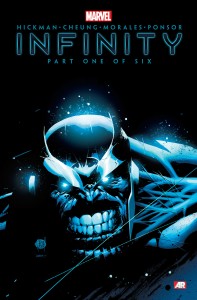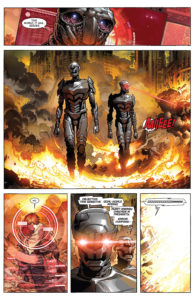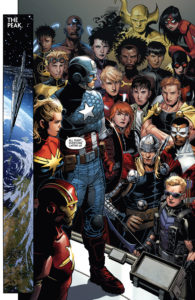Monthly comic books are a bit like the local nightly news.
Whether a day is exciting or not, or whether you care or not, your local nightly news will find something to say about it. I haven’t seen it for over a decade, but some people watch it daily. Others just tune in when there is a big story to report on.
Ongoing comic books are a lot like that. They just keep happening, issue after issue, while comic book publishers find new things about them to hype every month. Some people devoutly collect each one, while others only buy stories with their favorite characters or creators.
Both in news and in comics, every once in a while there is a big event. A big news event is the kind of thing that causes TV networks to break into their regularly scheduled programming with an update from the national news bureau, and might keep you refreshing Twitter or CNN all day long.
Comic books have the equivalent in line-wide event books. These limited-run titles signal the arrival of a massive, world-altering story too big in scope to contain in a single 22-page issue. However, much like big news events, sometimes comic events are a lot of sound and fury signifying nothing, and after all the breathless coverage you wonder what the big deal was.
Which brings us to today’s topic…
 Infinity #1 of 6
Infinity #1 of 6 

Script and graphic design by Jonathan Hickman. Pencils by Jim Cheung. Inks by Mark Morales with John Livesay, David Meikis, and Jim Cheung. Color art by Justin Ponsor.
Rating: 2.5 of 5 – Okay
#140char review: Infinity #1: Hickman reveals a long-term plot in steady pulses. As usual, Cheung’s heroes are all thin-lipped teens. Solid (if bland) set-up
CK Says: Consider it.
Jonathan Hickman excels at writing entire forests of plot and motivations, and in the end Infinity #1 is just a single tree.

You can tell that important plot points are being set up here. You can feel that certain foreboding exposition is actually the punch line of a dark joke we won’t be told for several issues.
Yet, on its own Infinity #1 just doesn’t excite.
Part of this is a heavy reliance on alien concepts (literally and figuratively). While the Giger-eseque alien Outrider and an entire subjugated society of Ahl-Gullo are made from whole cloth, bringing Space Knights back from the brink of obscurity is a delight. However, the resultingly spare speaking panels full of heroes leaves this thick book feeling a bit light on content.
Of those, only Captain America, Hawkeye, and Black Bolt get significant screen time here, and none of them are actually significant. The former two feel as though they appear just to appease whiners like me, though Black Bolt certainly makes his presence felt (and heard).
Jim Cheung is drawing both the bookends of this series, and those positions are likely the wisest choice. Cheung excels at creatures, cityscapes, gear, and explosions – all guaranteed in the opening and closing installments. His widescreen alien action will make you realize why comic book movies will never top the sheer audacity of settings and casting of actual comics.

That said, films do have one up on Cheung: he’s merely average on faces. His heroes are no Robert Downey Jr. and Scarlett Johansson, handsome and distinct. Every last human being has the same thin-lipped, constipated teenager face – Cap’s just has a few extra wrinles. It made Cheung unmissable on Young Avengers and Children’s Crusade, but annoying here. His action is unclear, making the nimble escape of the Outrider a confusing muddle.
The real art-star of this book is colorist Justin Ponsor, who finds middle ground between Dean White reversed-white shading and Marvel’s infamously orange sunset color scheme. From the haunting red of the sunken eye-sockets of a tortured Caretaker to the dusty rainbow of superhero costumes pressed together in a chilly cargo hold, Ponsor finds the right tone for every page. It’s he who knocks it out of the park for the best splash pages of the book – the visceral vibration effect on Black Bolt’s seismic whisper and two full pages of Thanos’s shadowed face.
The lack of thrill in issue one isn’t a mood-killer. Hickman has yet to pen a disappointing arc of comics. The next two artists – Opena and Weaver – are two of the best in Marvel’s stable. And, in addition to five additional issues of Infinity, we’re also due for nine key Avengers issues to expand the plot – so, it’s likely Avengers #18 and New Avengers #9 will fill in the character beats I sorely missed in this issue. Plus, once we’ve traversed the entire forest, this particular tree will probably look much more interesting.
This isn’t a bad comic book, but you probably won’t go wrong simply picking up #2 when it hits in a few weeks.
PS: If you can, pick this book up digitally for a rather impressive Silver Surfer back-up story that isn’t present in the print edition.